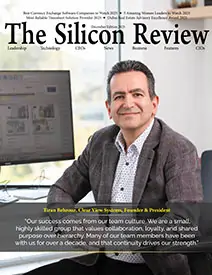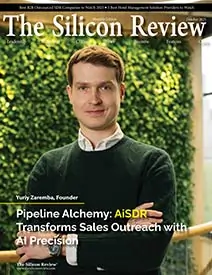Trusted by Top-Rated Corporations, Marvelution, an Assendelft-Based Software Company, Continues to Lead Providers Offering Jira Solutions
The Silicon Review
![]()
“Over time the solution needed to be tweaked a couple of times to handle even bigger scales of Jira and Hudson.”
Marvelution is a software company that simplifies Jenkins Integration in Jira. It primarily focuses on the Jenkins Integration for Jira app and some supporting open source projects. The company serves clients worldwide.
Marvelution was founded in 2015 and is based in Assendelft, North-Holland.
To highlight and further understand what Marvelution stands for and seeks to explore in this segment, I sat down with Mark Rekveld, who is the founder of the company.
Below is an excerpt.
Q. What’s your story? And what led you to the establishment of Marvelution?
The story of Marvelution starts in 2007. In February of the same year, I graduated bachelor Informatics and moved from the student life to the work one. I started at a big consulting firm, thinking I could learn interesting things moving from one project to the next. At the time Service Oriented Architecture, or SOA, was a trend and most projects use this in one way or another. But I quickly realized that the vast majority of the projects were using solutions of the big names such as IBM, Oracle, Web Logic, etc. Great things from the open-source community like Apache Camel, RabbitMQ, or the Spring Framework were not used but had great potential in those projects. The funny thing was that the open-source solutions would produce a “in my eyes” better solution at a lower cost. But the “it’s not supported” excuse was used to keep with the big names, even though support was far better within the open-source community, as it’s not just the project group of the product giving support, but most of the users of them as well.
This got me thinking that I liked the project-based working and helping clients out with a solution that best fit them, but at the same time, I was not going to learn to use the interesting and fast-moving open source projects where I saw a big potential. So I opted to start learning outside of work, in the evenings and weekends. Using interesting open-source projects and playing around with them, I quickly realized that I needed to put some structure in place for building, testing, and managing what I wanted to do.
Searching for structure solutions I came across Atlassian Jira and Hudson. Atlassian Jira is a project management tool and Hudson is a Continuous Integration tool. Using these tools I was able to put some structure in place which helped me to organize my time.
After this structure was in place for a while, I found that I was switching a lot between Jira and Hudson to see if builds in Hudson related to issues in Jira were successful or not. This drove me to integrate to save time app and context switching. The out-of-the-box solution however opted to add comments to issues that became problematic for me. More and more people over the globe started to use my hobby projects and were also helping out with feedback like comments on issues. But these comments were getting “lost” between the build comments on Hudson. So I opted to see if I could design and build a solution that fit my use case better, providing tight integration without loss of information.
This led to the Jira Hudson Integration project to be started in early 2008 and since Marvelution was an open-source hobby, this project would also be open source and available to whoever wanted to use it. As it turns out, I was not the only one looking for a different integration solution. A lot of other people also wanted to use the project and were giving loads of feedback to help improve the project. Over time the solution needed to be tweaked a couple of times to handle even bigger scales of Jira and Hudson. Fast forward to 2015, I got the opportunity to establish Marvelution, the company. Some of the projects didn’t stand the test of time, but the Jira Hudson Integration project did but was rebranded as the Jenkins Integration for Jira app. With the formal company behind the project, I was able to up the support capabilities from best-effort to SLA based, and this also saw support for Jira Data Center and Jira Cloud be added to the Jenkins Integration for Jira app. Nowadays, Marvelution primarily focuses on the Jenkins Integration for Jira app and some supporting open source projects.
Q. When it comes to emotional branding, Marvelution sounds highly promising. As a journalist, I find it quite striking. My question to you is, how did you come up with the brand name, and what does it depict?
Marvelution is a portmanteau; a blend of two different words—Marvelous and Solution. Years later I came in contact with someone that thought it stood for “Marks Evolution” which also sounds nice.
I came to pick “marvelous” and “solution” by looking at what I wanted to do with the, at the time, hobby project. I wanted to create great things that would solve a problem. Great things tend to be marvelous and you solve a problem with a solution.
![]()
Q. ‘Marvelution simplifies Jenkins site management in Jira.’ Splendid. Would you like to talk about this a bit more?
Back in the day when it all started, I wanted to create a simple and easy manage the integration between Jenkins and Jira. It should not take more time to manage if the number of jobs in Jenkins or projects in Jira grew for me. That was very important to me as it was a one-man hobby and I wanted to learn new things and not have to manage the infrastructure all the time. So I opted for a single source of truth solution where either Jenkins or Jira would be the absolute truth for the configuration and the other would follow that truth. For me, Jira was the better pick for storing the truth as this better supported storing information is needed for the integration.
This formed an integration path where a user would; 1) install the Jira app, 2) install the Jenkins plugin, and 3) configure a Jenkins site in Jira. The rest would then be handled by the integration app. All the user had to do was to make sure that Jira issue keys were used when triggering a build in Jenkins so that the integration app could index this. Adding a Jira issue key to commit messages or branch names was already a best practice used widely so the integration app simply adopted this behavior making it easy to adopt the app.
Over time more features have been added, but the required installation and configuration steps remain a simple 1.2.3 to get started using the app.
Q. What can you tell us about your Jenkins Integration for Jira platform? And how intelligently does it unlock the value of software development?
I think the intelligent-s of the Jenkins Integration for Jira platform comes in the form that developers and administrators don’t need to alter their method of working. Just install and configure once, in one place. This makes it easy to manage for administrators and since the integration depends on issue keys being used during the development process, which developers already do, they don’t have to update their workflow. Sometimes making the integration almost invisible is the best way to allow for easy adoption.
Once the data is available in Jira, then the insight into build relations and impact can be viewed by all that use Jira, be it a developer that wants to know if builds related to his ticket is passing, a release engineer that wants to know the status of the tickets to be included in the upcoming release or the release process itself. Just to name two.
Q. What are your focus areas? Please share an overview.
Scalability of the Jenkins Integration for Jira cloud app. The cloud version of the app has seen and is still seeing growth in demand to the point where the limits of the current environment could be reached sometime early next year. To this end, a redesign of the environment is underway to make sure the app can scale up and down as demand increases during working days and decreases during the off-hours. It is not a polished or great new feature that customers will see, but it will be something they will experience in the performance of the app.
Q. You must be decisive and persistent to succeed in this competitive industry. That said, how do you plan to combat your competition?
I have always been open, honest, and direct with customers and users. And I think this is one of the main success factors of Marvelution. Of course, I have my ideas on how to provide services or products and what new features will be next, but listening to customers and their needs gives great insight into what they need, and this can, in turn, be used to update the road forward.
I also don’t keep a close eye on the competition; I kind of run my race, building things that I think are useful or that customers have been asking for. If you only look at others then you lose a lot of time that you cannot get back and the result of copying their success is by no means a guarantee that it will be successful for you as well. Just do what you do best and listening to others is how I think I can be successful.
Q. Will your company be expanding, bringing on any new products or services that we should be aware of?
One of the things very important to me is having fun working, this is one of the main reasons I started the hobby in 2007 and the company in 2015. If expanding the company, be it new products, services, or employees, is needed to keep having fun then yes it will. I am not in the game to grow, grow and grow some more. I want to enjoy working, providing the services and products Marvelution has. If the need comes to expand to keep providing the services and products I stand by then that will be the key reason to expand. Expanding only to make more money is not a valid reason and would also give more stress cutting in on the fun and happiness.
Q. How do you plan to transform your company into a future that is unfolding before you?
I am not planning to transform Marvelution for the future. Instead, I am running my race, so to speak by looking at what the customers and products/services need and adapt to that. Currently, the adoption of changes, like the before mentioned scalability focus area, is something I can manage myself. Also support requests from customers are not overwhelming and can be quickly actioned on by me. With that said, I do have people that I can depend on in a transformation.
Mark Rekveld | Founder
Mark Rekveld is the founder of Marvelution. His professional journey started in 2002 when he decided to start his bachelor's degree in Informations after finishing college. He finished his bachelor's degree in February of 2007 after which he started working for a big consulting firm. He has always had a great drive to learn. Software development in Java was not something that was greatly taught during his bachelor’s, so he opted to learn it himself. This self-teaching continued afterward at work as well where the interesting open source projects were not used. Seeing the benefit of those projects and having the drive to learn about using them, Mark started learning about projects and by “playing around” with interesting open-source projects. This led to the creation of Marvelution, eventually.
_2025-12-15_12-44-58.webp)


_2025-11-17_06-38-14.webp)

 (1)_2025-10-21_13-35-14.webp)
